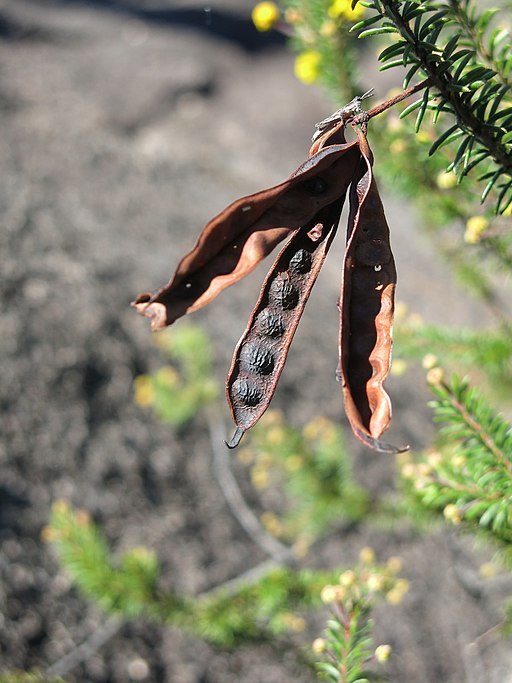Classification System: APG IV
Superregnum: Eukaryota
Regnum: Plantae
Cladus: Angiosperms
Cladus: Eudicots
Cladus: Core eudicots
Cladus: Rosids
Cladus: Eurosids I
Ordo: Fabales
Familia: Fabaceae
Subfamilia: Caesalpinioideae
Tribus: Acacieae
Genus: Acacia
Species: Acacia beadleana
Name
Acacia beadleana R.H.Jones & J.J.Bruhl
Distribution
Native distribution areas:
Acacia beadleana
Continental: Australasia
Regional: Australia
New South Wales
References: Brummitt, R.K. 2001. TDWG – World Geographical Scheme for Recording Plant Distributions, 2nd Edition
References
Primary references
Jones, R.H. & Bruhl, J.J. 2006. Acacia beadleana (Fabaceae: Mimosoideae), a new, rare localised species from Gibraltar Range National Park, New South Wales. Proceedings of the Linnean Society of New South Wales 127: 6 (5–10).Reference page.
Links
Govaerts, R. et al. 2020. Acacia beadleana in Kew Science Plants of the World online. The Board of Trustees of the Royal Botanic Gardens, Kew. Published on the internet. Accessed: 2020 Jul 26. Reference page.
International Plant Names Index. 2018. Acacia beadleana. Published online. Accessed: Jan 23 2018.
Acacia beadleana in: Australian Plant Census (APC) 2018. IBIS database, Centre for Australian National Biodiversity Research, Council of Heads of Australasian Herbaria. Accessed: 2018 Jan 23.
Vernacular names
Acacia beadleana is a shrub that is endemic to New South Wales.
Description
The shrub typically grows to a height of 0.4 to 2 m (1 ft 4 in to 6 ft 7 in) with terete hairy branchlets. Like most species of Acacia it has phyllodes rather than true leaves. The thick, terete, evergreen phyllodes are crowded on the stems and inclined to patent, they have a linear-oblanceolate shape and are shallowly to moderately recurved and have sparse to dense spreading hairs. The phyllodes can be slightly scabrous and have a length of 8 to 12 mm (0.31 to 0.47 in) and a width of 0.6 to 1.5 mm (0.024 to 0.059 in). It blooms between January and February and produces simple inflorescences that occur singly in the axils and are supported by slender, hairy peduncles. The large spherical flower-heads contain 25 to 50 densely packed bright yellow to golden flowers. After flowering glabrous and coriaceous seed pod form. The dark brown oblong shaped pods have a length of 35 to 50 mm (1.4 to 2.0 in) and a width of 8 to 12 mm (0.31 to 0.47 in). The seeds within are arranged transversely and are around 4 mm (0.16 in) in length with a short arillate funicle.[3]
Taxonomy
The species was first formally described by the botanists Jeremy James Bruhl and Rodney H.Jones in 2006 as published in the Proceedings of the Linnean Society of New South Wales.[4] The specific epithet honours Professor Noel Charles William Beadle, who was foundation Professor of Botany at the University of New England and a noted taxonomist and ecologist.[5]
Distribution
It is found in the Gibraltar Range in north western New South Wales along granite ridges and rocky slopes among granite outcrops growing in sandy soils in heath or open Eucalyptus woodland communities.[3] The species has only a few known populations with only around 100 plants in each mostly found within the Gibraltar Range National Park.[6]
Acacia beadleana
Seed pods
habitat
regrowth & burnt trunk
See also
List of Acacia species
References
"Acacia beadleana". Australian Plant Name Index, IBIS database. Centre for Plant Biodiversity Research, Australian Government. Retrieved 27 July 2019.
Jones, R.H.; Bruhl, J.J. (2006). "Acacia Beadleana (Fabaceae: Mimosoideae), a New, Rare, Localised Species from Gibraltar Range National Park, New South Wales". Proceedings of the Linnean Society of New South Wales. 127: 6–9, Figs 1, 2. Retrieved 27 July 2019.
"Acacia beadleana". World Wide Wattle. Western Australian Herbarium. Retrieved 29 April 2019.
"Acacia beadleana R.H.Jones & J.J.Bruhl". Atlas of Living Australia. Global Biodiversity Information Facility. Retrieved 31 August 2019.
"Acacia beadleana R.H.Jones & J.J.Bruhl". PlantNet. Royal Botanic Garden, Sydney. Retrieved 31 August 2019.
"Acacia beadleana R.H.Jones & J.J.Bruhl". Wattle - Acacias of Australia. Lucid Central. Retrieved 31 August 2019.
Retrieved from "http://en.wikipedia.org/"
All text is available under the terms of the GNU Free Documentation License


